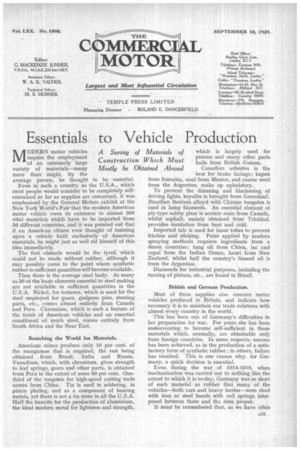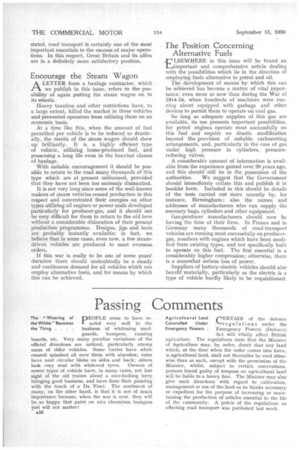Essentials to Vehicle Production
Page 17

Page 18

If you've noticed an error in this article please click here to report it so we can fix it.
MODERN motor vehicles require the employment of an extremely large variety of materials—many more than might, by the average person, be thought to be essential. Even in such a country as the -U.S.A., which most people would consider to be completely selfcontained so far as supplies are concerned, it was emphasized by the General Motors exhibit at the New York World's Fair that the modern American motor vehicle owes its existence to almost 300 vital materials which have to be imported from 56 different countries, and it was pointed out that if an American citizen ever thought of insisting upon a vehicle built exclusively of American materials, he might just as well rid himself of this idea immediately. The first obstacle would be the tyres, which could not be made without rubber, although it may possibly come to the point where synthetic rubber in sufficient quantities will become available.
Then there is the average steel body. As many as 20 of the basic elements essential to steel making are not available in sufficient quantities in the U.S.A. Nickel, for instance, which is used for the steel employed for gears, gudgeon pins, steering parts, etc., comes almost entirely from Canada and Peru. Chromium, which is such a feature of the finish of American vehicles and an essential constituent of much steel, comes entirely from South Africa and the Near East.
Searching the World for Materials.
American mines produce only 10 per cent. of the manganese that is required, the rest being obtained from Brazil, India and Russia. Vanadium, which, with chromium, gives strength to leaf springs, gears and other parts, is obtained from Peru to the extent of some 60 per cent. Onethird of the tungsten for high-speed cutting tools comes from China. Tin is used in soldering, in piston plating, and as a component of bearing metals, yet there is not a tin mine in all the U.S.A. Half the bauxite for the production of aluminium, the ideal modern metal for lightness and strength, which is largely used for pistons and many other parts hails from British Guiana.
Canadian asbestos is the best for brake facings; kapok from Sumatra, sisal from Mexico, and coarse wool from the Argentine, make up upholstery.
To prevent the dimming and blackening of driving lights, kryolite is brought from Greenland. Brazilian thorium alloyd with Chinese tungsten is used in lamp filaments. An essential element of ply-type safety glass is acetate resin from Canada, whilst asphalt, mainly obtained from Trinidad, provides insulation from heat and cold.
Imported talc is used for inner tubes to prevent friction and sticking. Paint applied by modern spraying methods requires ingredients from a dozen countries; tung oil from China, lac and copal from the Indian Ocean, kauri from New Zealand, whilst half the country's linseed oil is from the Argentine.
Diamonds for industrial purposes, including the turning of pistons, etc., are found in Brazil.
British and German Production.
Most of these supplies also concern motor vehicles produced in Britain, and indicate how necessary it is to maintain our trade relations with almost every country in the world.
This has been one of Germany's difficulties in her preparation for war. For years she has been endeavouring to become self-sufficient in those materials which, normally, are obtainable only from foreign countries. In some respects,success has been achieved, as in the production of a satisfactory form of synthetic rubber ; in others, failure has resulted. This is one reason why, for Germany, a quick decision is essential.
Even during the war of 19144918, when mechanization was carried out to nothing like the extent to which it is to-day, Germany was so short of such material as rubber that many of the vehicles—both cars and heavy lorries—were shod with iron or steel bands with coil springs interposed between them and the rims proper.
It must be remembered that, as we have often stated, road transport is certainly one of the most important essentials to the success of major operations. In this respect, Great Britain and its allies are in a definitely more satisfactory position.
Encourage the Steam Wagon
ALETTER from a haulage contractor, which we publish in this issue, refers to the possibility of again putting the steam wagon on to its wheels.
Heavy taxation and other restrictions have, to a large extent, killed the market in these vehicles and prevented operators from utilizing them on an economic basis.
At a time like this, when the amount of fuel permitted per vehicle is to be reduced so drastically, the merits of the steam wagon should show up brilliantly. It is a highly efficient type of vehicle, utilizing home-produced fuel, and possessing a long life even in the heaviest classes of haulage.
With suitable encouragement it should be possible to return to the road many thousands of this type which are at present unlicensed, provided' that they have not been too seriously dismantled.
It is not very long since some of the well-known makers of steam vehicles ceased production in this respect and concentrated their energies on other types utilizing oil engines or power units developed particularly for producer-gas, and it should not be very difficult for them to return to the old love without a considerable dislocation of their present production programmes. Designs, jigs and tools are probably instantly available; in fact, we believe that in some cases, even now, a few steamdriven vehicles are produced to meet overseas orders.
If this war is really to be one of some years' duration there should undoubtedly be a steady and continuous demand for all vehicles which can employ alternative fuels, and for means by which this can be achieved:.
The Position Concerning Alternative Fuels
LSEWHERE in this issue will be found an important and comprehensive article dealing with the possibilities which lie in the direction of employing fuels alternative to petrol and oil.
The development of means by which this can be achieved has become a matter of vital importance; even more so now than during the War of 1914-18, when hundreds of machines were running about equipped with gasbags and other devices to permit them to operate on 'coal gas.
So long as adequate supplies of this gas are available, its use presents important possibilities, for petrol engines operate most successfully on this fuel and require 110 drastic modification beyond the provision of suitable carburetting arrangements, and, particularly in the case of gas under high pressure in cylinders, pressurereducing valves.
A considerable amount of information is available from the experience gained over 20 years ago, and this should still be in the possession of the authorities. We suggest that the Government should immediately collate this and publish it in booklet form. Included in this should be details of the tests carried out more 'recently by, for instance, Birmingham ; also the names and addresses of manufacturers who can supply. the necesary bags, cylinders and other equipment.
Gas-producer manufacturers should now be having the time of their lives, In France and in Germany many thousands of road-transport vehicles are running most successfully on producergas, numbers with engines which have been modified from existing types, and not specifically built to operate on this fuel. The first essential is a considerably higher compression; otherwise, there is a somewhat serious loss of power.
Suppliers of battery-electric vehicles should also benefit materially, particularly as the electric is a type of vehicle hardly likely to be requisitioned.




























































